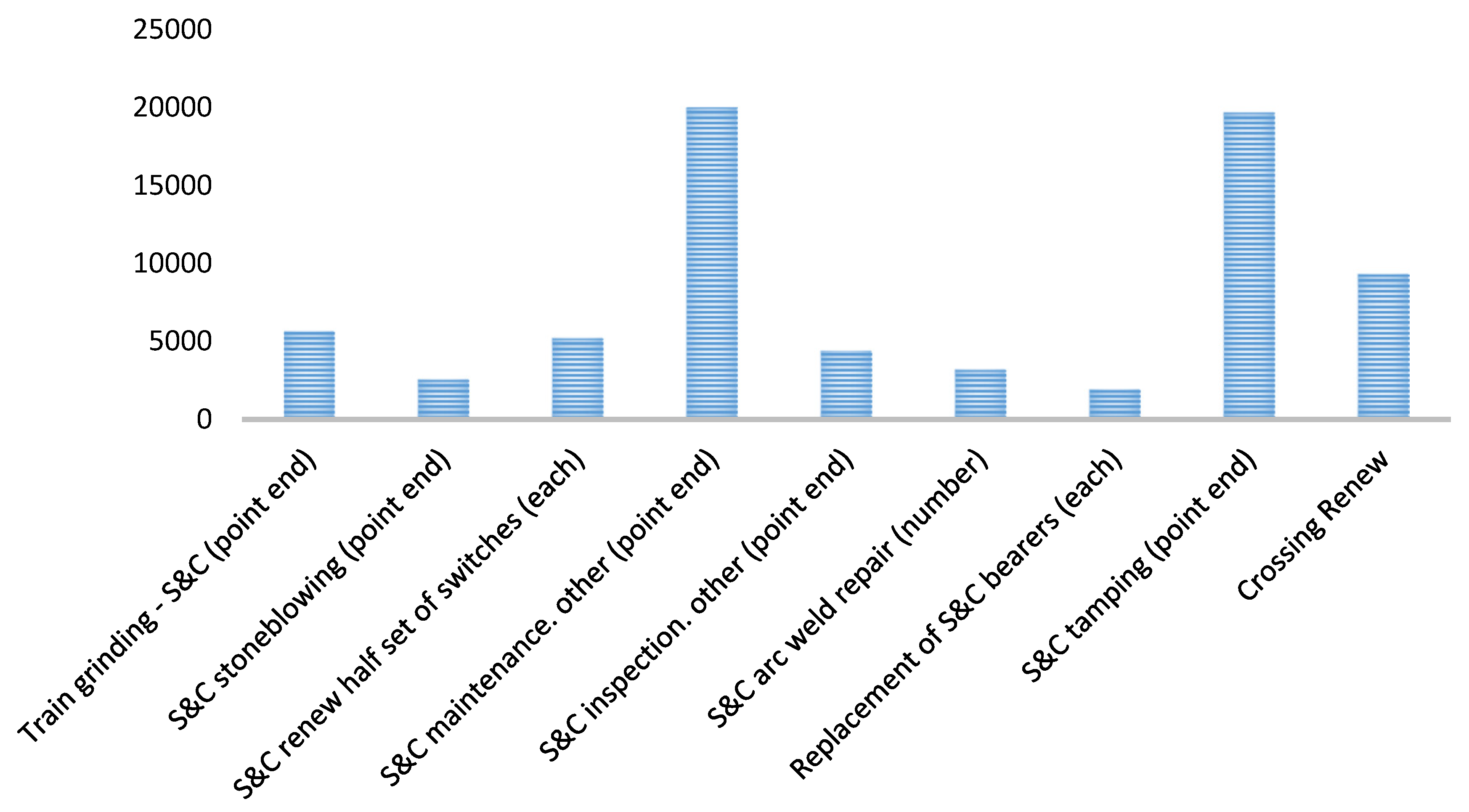A Stochastic Approach for Life-Cycle Cost Analysis of Railway Turnouts Exposed to Climate Uncertainties †
Acknowledgments
References
- Kaewunruen, S. Monitoring structural deterioration of railway turnout systems via dynamic wheel/rail interaction. Case Stud. Nondestruct. Test. Eval. 2014, 1, 19–24. [Google Scholar] [CrossRef]
- Nissen, A. LCC analysis for switches and crossings: A case study from the Swedish Railway Network. Int. J. COMADEM 2009, 12, 10–19. [Google Scholar]
- Siew, S.; Mirza, J.O.; Kaewunruen, S. Torsional effect on track-support structures of railway turnouts crossing impact. J. Transp. Eng. Part A Syst. 2016, 143. [Google Scholar] [CrossRef]
- Remennikov, A.M.; Kaewunruen, S. Experimental load rating of aged railway concrete sleepers. Eng. Struct. 2014, 76, 147–162. [Google Scholar] [CrossRef]
- Andersson, C.; Dahlberg, T. Wheel/rail impacts at a railway turnout crossing. Proc. Inst. Mech. Eng. Part F J. Rail Rapid Transit 1998, 212, 123–134. [Google Scholar] [CrossRef]
- Dindar, S.; Kaewunruen, S.; Sussman, J.M. Climate Change Adaptation for GeoRisks Mitigation of Railway Turnout Systems. Procedia Eng. 2017, 189, 199–206. [Google Scholar] [CrossRef]
- Bin Osman, M.H.; Kaewunruen, S.; Jack, A. Optimisation of schedules for the inspection of railway tracks. Proc. Inst. Mech. Eng. Part F J. Rail Rapid Transit 2017, 232. [Google Scholar] [CrossRef]
- Pålsson, B.A. Optimisation of railway crossing geometry considering a representative set of wheel profiles. Veh. Syst. Dyn. 2015, 53, 274–301. [Google Scholar] [CrossRef]
- Kaewunruen, S.; Remennikov, A.M. Sensitivity analysis of free vibration characteristics of an in situ railway concrete sleeper to variations of rail pad parameters. J. Sound Vib. 2006, 298, 453–461. [Google Scholar] [CrossRef]
- EIM-EFRTC-CER. Market Strategy Report—Track Maintenance & Renewal; The Community of European Railway and Infrastructure Companies (CER): Brussels, Belgium, 2012.
- Hamarat, M.; Kaewunruen, S. Life-Cycle Cost Analysis of Railway Turnouts Exposed to Climate Uncertainties. In Proceedings of the The 3rd World Multidisciplinary Civil Engineering—Architecture—Urban Planning Symposium, Prague, The Czech Republic, 18–22 June 2018. [Google Scholar]
- Kaewunruen, S.; Sussman, J.M.; Matsumoto, A. Grand Challenges in Transportation and Transit Systems. Front. Built Environ. 2016, 2, 4. [Google Scholar] [CrossRef]
- Tuler, M.V.; Kaewunruen, S. Life cycle analysis of mitigation methodologies for railway rolling noise and groundbourne vibration. J. Environ. Manag. 2017, 191, 75–82. [Google Scholar] [CrossRef]
- Vitásek, S.; Měšťanová, D. Life Cycle Cost of a Railroad Switch. Procedia Eng. 2017, 196, 646–652. [Google Scholar] [CrossRef]
- Kaewunruen, S.; Sussman, J.M.; Einstein, H.H. Strategic framework to achieve carbon-efficient construction and maintenance of railway infrastructure systems. Front. Environ. Sci. 2015, 3, 6. [Google Scholar] [CrossRef]
- Kaewunruen, S.; Remennikov, A.M. Experimental simulation of the railway ballast by resilient materials and its verification by modal testing. Exp. Tech. 2008, 32, 29–35. [Google Scholar]

Publisher’s Note: MDPI stays neutral with regard to jurisdictional claims in published maps and institutional affiliations. |
© 2018 by the authors. Licensee MDPI, Basel, Switzerland. This article is an open access article distributed under the terms and conditions of the Creative Commons Attribution (CC BY) license (https://creativecommons.org/licenses/by/4.0/).
Share and Cite
Hamarat, M.; Kaewunruen, S. A Stochastic Approach for Life-Cycle Cost Analysis of Railway Turnouts Exposed to Climate Uncertainties. Proceedings 2018, 2, 1142. https://doi.org/10.3390/proceedings2161142
Hamarat M, Kaewunruen S. A Stochastic Approach for Life-Cycle Cost Analysis of Railway Turnouts Exposed to Climate Uncertainties. Proceedings. 2018; 2(16):1142. https://doi.org/10.3390/proceedings2161142
Chicago/Turabian StyleHamarat, Mehmet, and Sakdirat Kaewunruen. 2018. "A Stochastic Approach for Life-Cycle Cost Analysis of Railway Turnouts Exposed to Climate Uncertainties" Proceedings 2, no. 16: 1142. https://doi.org/10.3390/proceedings2161142
APA StyleHamarat, M., & Kaewunruen, S. (2018). A Stochastic Approach for Life-Cycle Cost Analysis of Railway Turnouts Exposed to Climate Uncertainties. Proceedings, 2(16), 1142. https://doi.org/10.3390/proceedings2161142





